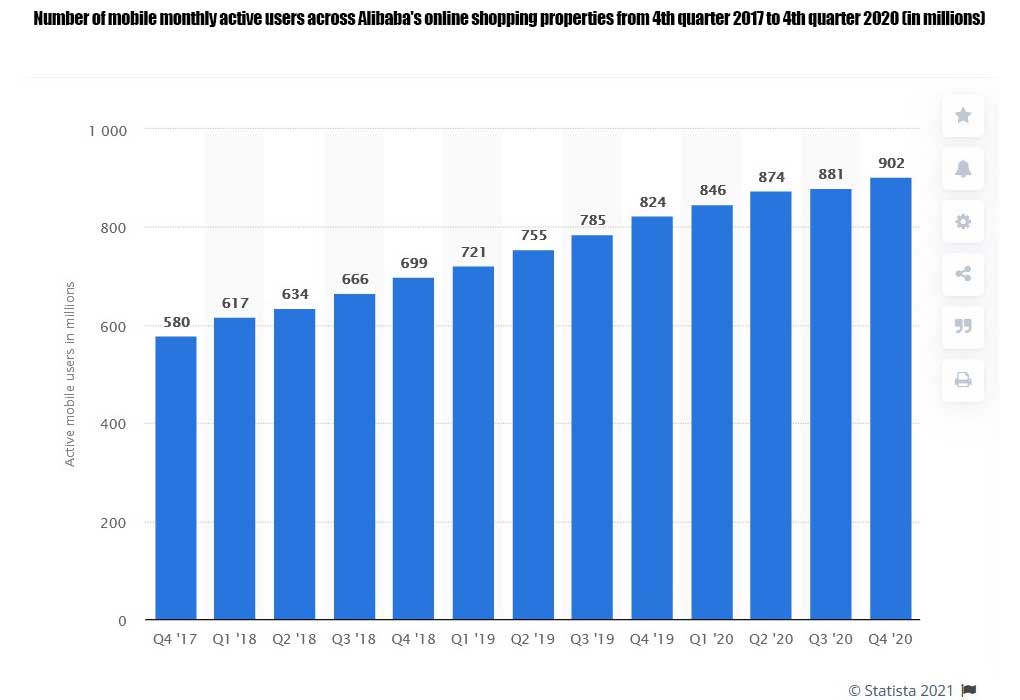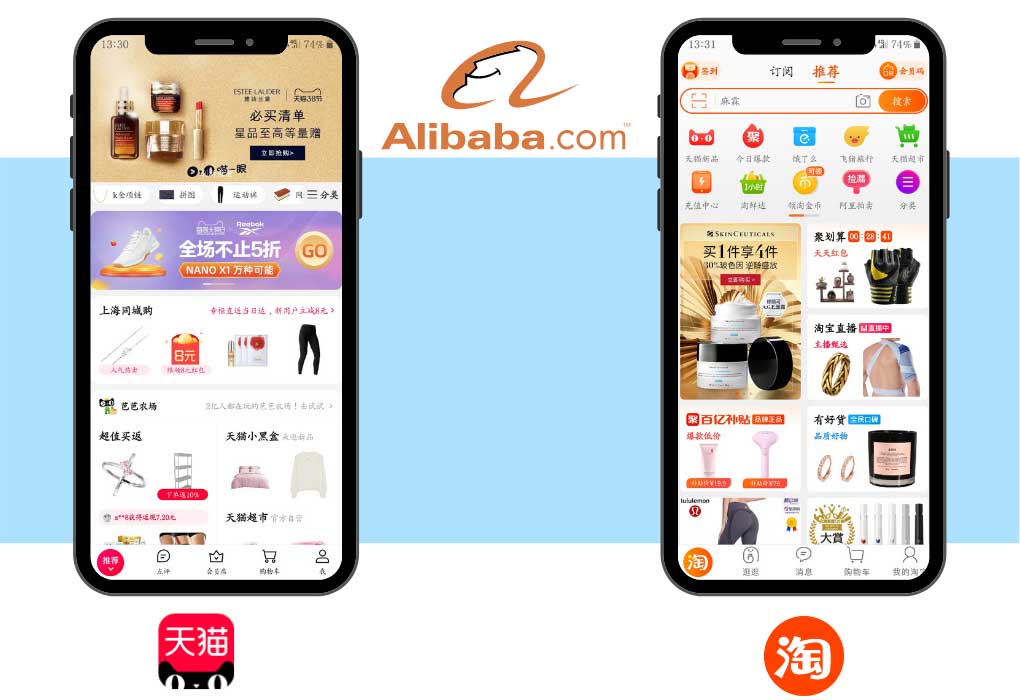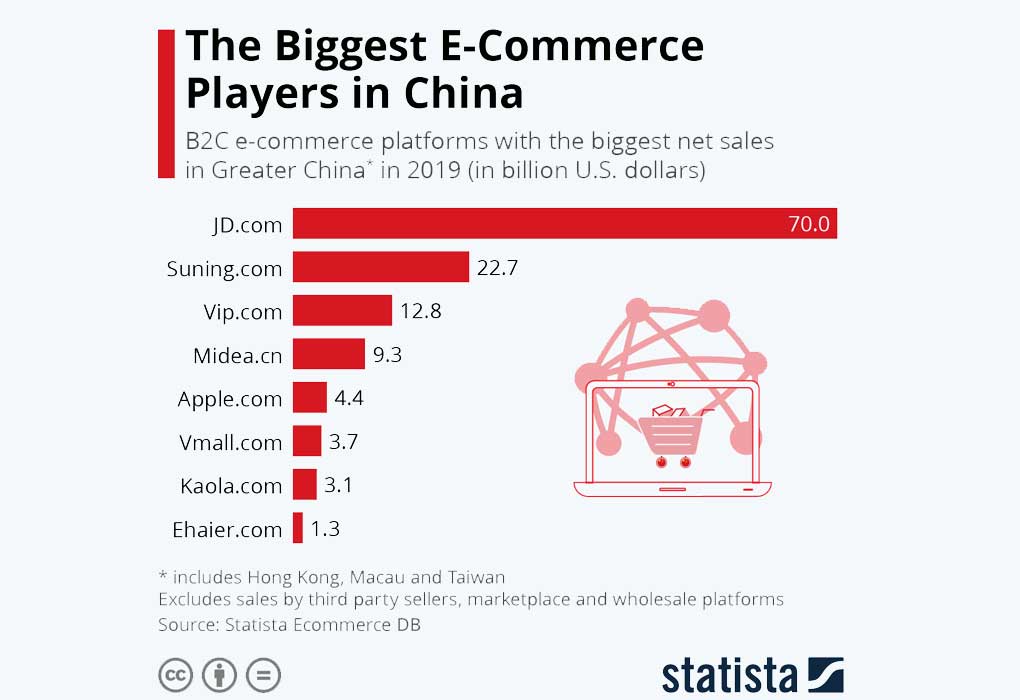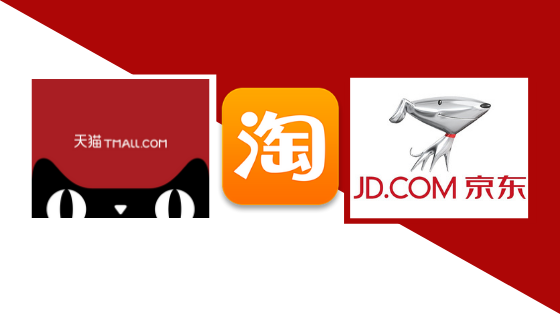China is an ever-growing power and most importantly the buying power of its middle class is increasing. Consumers are willing to spend their money and can you guess where their favorite place to shop is? Yep, you are right: Taobao, Tmall, and JD. If you are looking forward to developing your e-commerce business in China, you’ve probably already done some research and have read about these three companies, but do you know in which aspects they differ? Let’s get right into it.
Introduction to Taobao
- Daily Active Users 300 Million (As of 2019)
- Taobao Mobile MAU: +100 Million (as of December 2020)
- Taobao Live: 400 Billion RMB in GMV (Year 2020)
- Taobao Deals Users: 100 Million ( Year 2020)

Taobao is one of the biggest e-commerce platforms based in China. It is owned by Alibaba and was launched in May 2003. The Taobao Marketplace is China’s largest C2C shopping destination. Merchants on Taobao are primarily individuals and small businesses – there are more than 10 million of them.
You can find anything you need on Taobao but you should know that the app is only available in Chinese. You can get clothes, accessories, gadgets, computer hardware at very low prices, you can even buy pets and second-hand goods. There are over one billion products listed and more than 300 million daily active users on Taobao’s app and the numbers are still growing.
It is worth mentioning, it is relatively easy to create a seller account on Taobao even for small businesses.
Looking into Taobao’s future
According to its chief marketing officer Chris Tung, Taobao is becoming the Chinese millennial platform to pursue success
“The trend we are observing is that for the younger generation, Taobao has become a platform that they identify with, can pursue their dreams […] over the last few years, those in the post-90s generation and even generation Z, have taken strides to open stores on Taobao and become owners and CEO’s of their own companies, growing their own brands.”
In short, there is a willingness to change the image of the platform. Taobao does not want to have its reputation linked to counterfeit products anymore and is, therefore, putting the accent on its young generation of passionate merchants looking forward to making a name with their creations.
Taobao has successfully embraced its new “making” culture and has attracted a younger audience looking for unique products and is even promoting its new philosophy through festivals such as Taobao Makers Festival.
If Taobao customers come from everywhere in the country and are of all ages, it seems clear that the company’s marketing efforts are focused on a younger generation of both sellers and consumers (Which seems to be working as millennials represented 70% of active users as of 2019). They are engaging their customers into communities and offering them a personalized experience with the help of their huge database.
Taobao’s best Tools
There are several tools within the Taobao ecosystem designed to help brands reach more consumers and assist in marketing efforts. These tools all have different functions but are effective in what they have been created to accomplish.
Weitao – Taobao’s intergrated Social Media
Weitao is a tool that is built into Taobao and T-Mall which serves as a sort of social media within the service. Brands and key opinion leaders (KOLs) can use Weitao to post content and engage consumers. On the other end, consumers can use Weitao to learn about new products, do product research, and engage with brands and KOLs that resonate with them.
This is an excellent system because all content concerning products can be linked directly to other pages within the app. That means that when consumers see something they like, they can go from seeing content to purchasing in a seamless way. This eliminates any extra steps that may be needed to otherwise convert a sale.
Taobao Live – Changing Online Shopping
Taobao Live is one of the most powerful tools that the service provides. As its name may suggest, Taobao Live is a live-video function within Taobao that allows businesses to share live content and answer questions from consumers in real-time. With the COVID-19 pandemic leaving many businesses unable to open their stores, Taobao live has seen a massive increase in popularity.
During the early onset of the pandemic, Taobao waived fees and requirements for brick-and-mortar stores to join Taobao Live which in turn resulted in an over 700% increase in new users from month to month. Taobao Live has been an excellent tool for traditional brick-and-mortar companies to adapt to an online presence. The use of Taobao Live is especially useful for businesses that sell large and relatively expensive products that consumers would traditionally rather see in person before purchasing such as cars and large appliances.
Fighting Pinduoduo with Taobao Deals
Following Pinduoduo C2M success (Manufacturer to Customers), Taobao has launched its own C2M services: Taobao Deals. The app targets area where Alibaba does not have as much influence as Pinduoduo, primarily, lower tiers cities. It is a fairly good success with 100 million users in 2020.
Tmall & JD.com: “PREMIUM” Chinese E-commerce Platform
Looking at the numbers, these two marketplaces really are both giants in their own respects but their models differ on a fundamental basis – although this is quickly changing.
Tmall: Incontested eCommerce Leader in China
Tmall and Taobao, after all, are both operated by Alibaba. Tmall, or “Tian-mao” was launched in 2008.

What is the difference between Taobao & Tmall?
As the two apps are linked to each other it can be very confusing to distinguish between the two at first. To be fair, when shopping on Taobao you are likely to be sent to a Tmall store, but never the opposite, and that is because the main difference lies in who sells on each of these platforms. Tmall is the biggest B2C e-commerce platform in China (it owns more than 55% of China’s B2C e-commerce market shares) and lists as many as 18,000 international brands with an incredible percentage of 80% of them never having done business in China before using T-mall.
When shopping on Taobao, customers tend to look for the best deals and unique products whereas, on Tmall, customers are looking for brands. In essence, this is a place where they can buy with their eyes closed.
Interesting fact: 70% of Tmall customers are between 24 and 32 and have an increasing purchasing power with a taste for imported products.
What are your options when opening a Tmall Store?
First of all, as we just mentioned, Tmall is a marketplace for trusted brands and products in demand with Chinese consumers, you will need to match some criteria to be able to open a Tmall store as well as pay storage fees.
- There must be a business entity located in Mainland China holding a Chinese retail business license.
- The product should also be located within Mainland China to quickly fulfill and ship orders when placed.
On Tmall as a seller, you’ll have the options to:
- Manage your own store and while it may feel troublesome you also have the possibility to personalize your storefront as you would like to.
- Work as a wholesaler – meaning that your product will be displayed by Tmall Store and have high visibility.
It is up to you to decide which option will fit your business objective the most but keep in mind that in both cases your product will have to match the quality standard of the marketplace.
JD: The contender

JD or Jing Dong is the largest self-operated e-commerce enterprise in China. JD has a strong focus on electronic devices but has rapidly been winning shares in the fresh grocery delivery, health supplements, fashion, and maternity care market.
What sets it apart from Alibaba’s Taobao and Tmall is its fulfillment service. JD has the most advanced fulfillment infrastructure among all Chinese e-commerce companies allowing same-day delivery. This is largely due to JD buying and storing goods. According to Dennis Hong, an investor at JD.com, this could be beneficial to the company growth:
“JD takes on inventory risk, it could achieve procurement scale over time and guarantee product quality in a country rampant with fake goods”
Why should you consider selling on JD?
In 2013, JD and Tencent announced the launch of a “Jingteng” plan. In other words, the two Chinese giants basically merged their databases offering a considerable advantage to JD’s merchants in terms of marketing. As of the third quarter of 2020, there were 441.6 million active users on the app.
Being present on JD not only opens a door to the Chinese e-commerce world but the platform also allows international companies to sell to Chinese consumers without the necessity of a physical presence in China.

Since 2017, JD.com has opened in South East Asia and is planning to go global in the near future.
The company with its focus on technology is always on top when it comes to using it to its advantage. For instance, JD is famous for working on developing a performance drone system to ensure an even faster fulfillment service.
JD has also emulated the trend of large e-commerce and tech giants in venturing into the grocery store industry. 7Fresh is the name of the grocery store chain that continues to grow even in direct competition to Alibaba’s Hema chain.
In 2020, JD launched its own integrated mini-program allowing merchants to promote additional services, consumers to orders delivery food via the JD app, and so on.
Tmall VS JD: interesting facts
Being one of the most common questions we get from companies looking to start selling online in China, here is a breakdown of the main differences between the two platforms.
- JD’s focus is on technology. Meaning that the two companies target different markets. Buyers will generally go to Tmall for clothes, cosmetics, and F&B purchases, whereas JD.com will be the number one choice for purchases of home appliances and electronic equipment. As mentioned above, this is quickly evolving and the distinction will disappear in the near future.
- Management fees are pretty similar, however, T-mall is cheaper (For a year ~ $1000 US vs ~1 to $10 000 US on JD.)
- The payment method differs. You’ll pay with Alipay and Bank Card on T-Mall and use Wechat Pay, JD Pay, or Bankcard on JD.
- Both Tmall and JD.com have their own cross-border platforms enabling foreign businesses to sell directly to China: Tmall Global and JD Worldwide.

If that is a topic that interests you, have a look at this post where we discuss the never-ending strategies of JD vs Tmall over international Brands.
Why (or why not) you should consider one of these options?
If you are still not sure whether or not you, as an e-commerce company, should join one of these marketplaces, let us remind you that we are talking about daily visits of millions of users, with an average conversion rate close to 30%. Some well-optimized stores can even reach an insane 50%.
What are the benefit of joining Taobao/Tmall or JD?
- The platforms already exist and have consumers’ trust.
- The payment method is already set up and thanks to WeChat payment and Alipay it has never been so easy for a customer to place an order.
- High visibility and easy targeting thanks to the huge customer database of these platforms.
- Assistance 24/7.
To sum things up, these companies have made shopping online an ultra-easy process, and being present on such a platform can offer better visibility to a confident customer ready to convert.
There has been tremendous growth in cross-border e-commerce (CBEC) over the last several years, in large part due to the aforementioned platforms. Growth is expected to continue. The Alibaba Group expects to import over $200 billion worth of goods through CBEC by 2023.
That said, being present on these chinese marketplaces is not always enough to succeed in China, in short, your success is going to depend on how well you understand the Chinese consumers and how you apply this knowledge into your marketing strategy.
Gentlemen Marketing Agency: Your eCommerce Patner & TP in China

You still aren’t sure and would like personalized expertise on your e-commerce project in China? Contact GMA and meet with our Chinese e-commerce specialists.



9 comments
Clarisse
Great post about the main e-commerce players in China.
2020 & 2021 numbers reveal that social e-commerce has grown significantly in the country (in 2020 WeChat Mini-Programs – estimated $248B GMV, Kuaishou $58B GMV, and Douyin – estimated $26B GMV). What is your take on this? Do you think Alibaba & JD have to worry, especially considering platforms like Pinduoduo swiping the Chinese e-commerce word almost out of nowhere?
타오바오 배송대행
I am really impressed with your writing skills and also with the
layout on your weblog. Is this a paid theme or did you modify it
yourself? Either way keep up the nice quality writing, it
is rare to see a nice blog like this one nowadays.
SMalik
Taobao products cannot be ordered from any other country? I mean no delivery services worldwide?
pepe
Hello, I am a selling dry fruit from Latin america, Which of this app would be better for starting my distribution in China?
benjamin robert sill
I am an author, have published 8 books and 4 articles. I would like to sell in China. So far I have not done anything and I hate to market.
Can you help me?
Olivier
Yes we can help you send us an email please
JosepE
I heard that 90% of Brands lose money on Tmall, it is true?
Marketa
Which Chinese e-commerce site do you prefer, JD.com or Tmall? You did not really Reply…